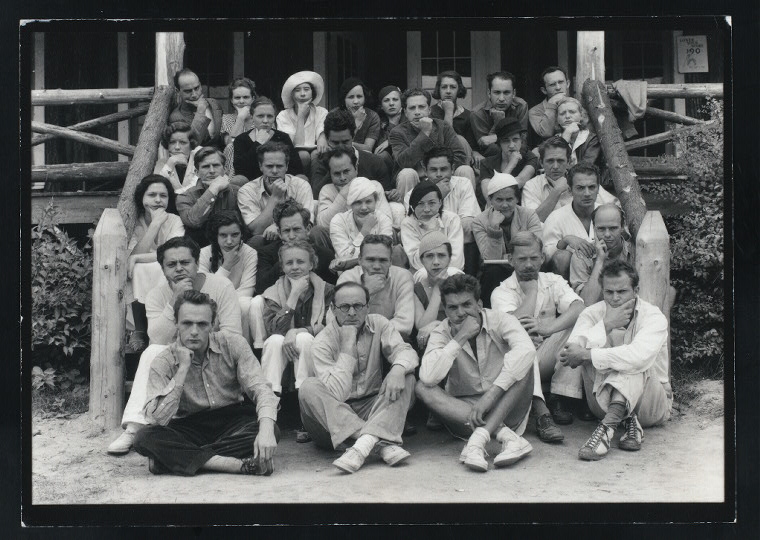
New York City in the 1930s was a cauldron of social and economic upheaval. It was against this backdrop that The Group Theatre, a revolutionary force in American theater, was born. Founded in 1931 by Harold Clurman, Cheryl Crawford, and Lee Strasberg, the Group Theatre wasn’t just about putting on plays; it was about creating a new kind of theater experience.
Breaking the Mold
Dissatisfied with the frivolous, lighthearted plays dominating the scene, the Group Theatre’s vision was a bold one. They championed:
- Naturalistic acting: Inspired by the teachings of Konstantin Stanislavski, the Group Theatre emphasized a realistic portrayal of characters, a stark contrast to the exaggerated performances of the time.
- Ensemble acting: The focus wasn’t on individual stars, but on a cohesive, believable unit. Actors honed their craft together, fostering a deep connection that translated to powerful onstage chemistry.
- Socially conscious plays: The Group Theatre staged original works by American playwrights that grappled with the harsh realities of the Great Depression and the struggles of the working class.
The Powerhouse Trio
Three names stand out amongst the Group Theatre’s impressive roster: Stella Adler, Lee Strasberg, and Sanford Meisner. While all three were instrumental in shaping the Group Theatre’s signature acting style, they each went on to make distinct contributions to American acting:
- Stella Adler: A passionate advocate for emotional truth in acting, Adler championed the importance of the actor’s imagination and subconscious in creating a character.
- Lee Strasberg: The “father” of Method acting, Strasberg focused on the actor’s inner life and emotional recall to build a character from the inside out. His approach, heavily influenced by Stanislavski’s teachings, became a cornerstone of American acting training.
- Sanford Meisner: Meisner, another key figure in the Method acting movement, emphasized the importance of living truthfully “in the moment” on stage, reacting authentically to fellow actors rather than following a predetermined script.
A Trailblazing Legacy
The Group Theatre’s run was tragically short-lived, disbanding in 1940 due to internal conflicts. However, its impact on American theater is undeniable. It launched the careers of some of the most important playwrights and actors of the 20th century, including Clifford Odets and Marlon Brando. More importantly, the Group Theatre’s commitment to ensemble acting, social commentary, and the Stanislavski method paved the way for a more realistic and emotionally resonant American theater tradition. The legacies of Adler, Strasberg, and Meisner continue to influence actors and acting schools around the world to this day.
Notable Plays of The Group Theatre
The Group Theatre, despite its short existence, produced a string of influential plays. Here are some of the most notable, along with their opening dates:
- The House of Connelly (1931) by Paul Green: This play tackled the sensitive subject of race relations in the South, sparking controversy and showcasing the Group Theatre’s commitment to social themes.
- Success Story (1932) by John Howard Lawson: This anti-capitalist play, though short-lived, marked the Group Theatre’s exploration of social commentary through drama.
- Men in White (September 1933 – July 1934) by Sidney Kingsley: A Pulitzer Prize winner, this play offered a realistic portrayal of the lives of interns and doctors, becoming the Group Theatre’s first major commercial success.
- Awake and Sing! (February 19 – July 27, 1935) by Clifford Odets: This powerful drama explored the struggles of a working-class Jewish family during the Depression and became a signature work of The Group Theatre.
- Waiting for Lefty (1935) by Clifford Odets: Another Odets masterpiece, this play, known for its iconic “Lefty” speech, brought social realism and working-class issues to the forefront of American theater.
- Johnny Johnson (1936) by Paul Green and Kurt Weill: This anti-war musical offered a scathing critique of militarism and patriotism.
- The Cradle Will Rock (1937) by Marc Blitzstein: This politically charged musical faced a government shutdown but found an alternate venue and became a symbol of artistic freedom.
- Golden Boy (1937-1938) by Clifford Odets: This play, exploring themes of ambition and corruption, became The Group Theatre’s biggest commercial success.
This list is not exhaustive, but it highlights some of the most enduring plays produced by The Group Theatre during its influential decade.

You must be logged in to post a comment.